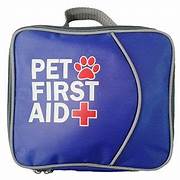|
Do You Have A Pet Emergency Kit? By Pierre Mouchette | Bits-n-Pieces No matter where you live, you risk facing a natural disaster. Daily we read and hear on the news about weather and climate disasters. Hurricanes, Wildfires, Tornadoes, severe storms, and flooding!
You may already know what to have on hand for yourself should you experience a disaster. But what about your pet? For pet owners, being prepared for a disaster could make all the difference to your furry friend’s survival. This article will discuss why you should have an emergency kit for your pet, what it should include, and the importance of having your pet’s identification items up to date. Why Is It Important To Have A Pet Emergency Kit? You have probably taught your pet many tricks, but unless you have shown them how to pack a suitcase or stock up on food goods, you cannot expect them to fend for themselves during an emergency. Your furry babies rely on you to protect and provide for their needs. A kit with everything your pet needs to survive for 1 to 2 weeks (with or without you) will keep them safe and secure and give you peace of mind. And it may just save your pet’s life. Many pet owners refuse to evacuate during emergencies without their pets because many emergency shelters do not allow pets. Past disasters have taught communities and rescue organizations the importance of being prepared. Some now have emergency shelters for pets; others welcome pets and their owners. An emergency kit will ensure you and your pet are ready to go with everything you need. What Should Be In A Pet Emergency Kit? Your kit should include everything your pet or pets need to survive for at least a week. Do not take anything for granted. Major emergency and rescue organizations recommend putting together a kit with the following items to ensure your pet’s well-being during a chaotic situation.
What To Put In A Pet First Aid Kit In addition to the above essentials, you will also want to include a basic pet first aid kit in your emergency pack. You can buy a pre-made kit online or from a local pet store. The cost of these kits varies based on the brand and size. If you prefer, you can also create your first aid kit. According to the American Veterinary Medical Association, your pet's first aid kit should include at least the following:
Make Sure Your Pet’s Identification Is Up To Date There are several important ways for your pet to be identified if you should be separated. These forms of identification should be updated whenever anything changes in your life, such as move to a new address, getting a new phone number, etc.
Getting A Back-Up Supply Of Your Pet’s Medication When an emergency strikes, you will not have time to visit your vet for extra medication. Make sure that you have a backup supply. Also, store additional preventative medications like flea and tick treatment. Check medication expiration dates regularly and highlight your pet’s name on labels. This is especially important if you have more than one pet. Get Copies Of Your Pet’s Medical And Vaccination Records Having your pet’s medical records is as important as having your medical records. If you adopt your pet from a shelter or get your pet from a friend or breeder, they should give you your pet’s file. Once you take your pet to a veterinarian, you can ask their office for copies of your pet’s records. Make sure their file includes the following:
0 Comments
Your comment will be posted after it is approved.
Leave a Reply. |
Archives
May 2024
|
